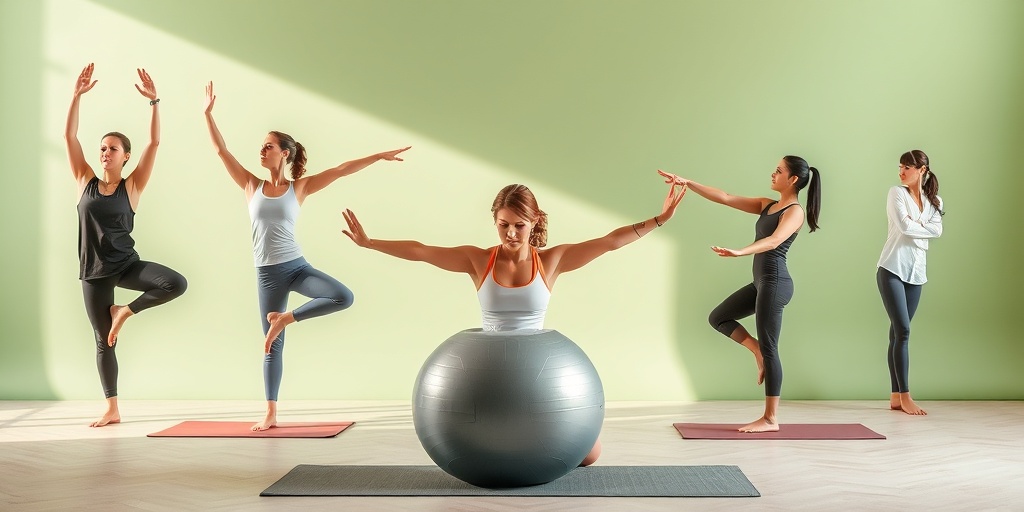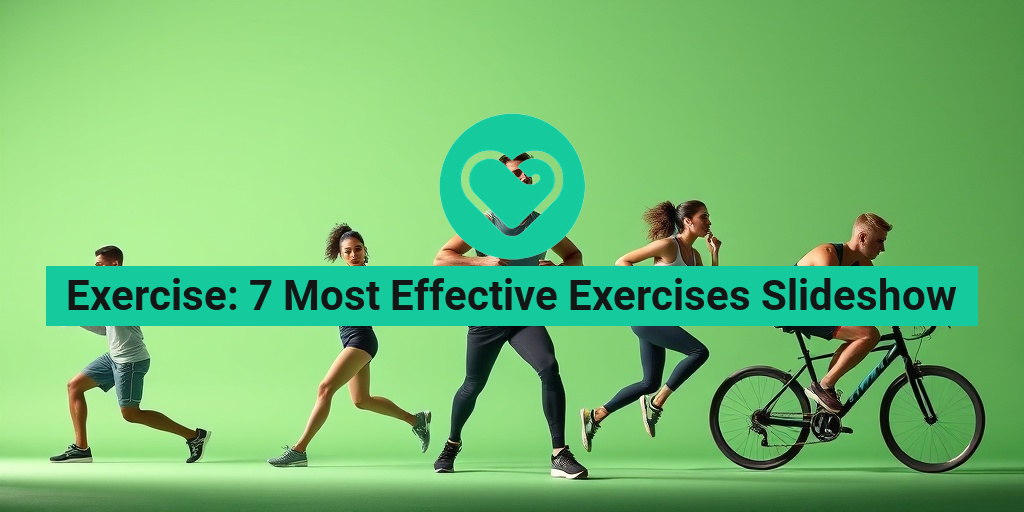Introduction to Effective Exercises
In today’s fast-paced world, finding time to exercise can be a challenge. However, incorporating effective exercises into your routine is crucial for maintaining overall health and well-being. Whether you’re a fitness enthusiast or just starting your journey, understanding which exercises yield the best results can make all the difference. In this article, we will explore the 7 most effective exercises that can help you achieve your fitness goals, improve muscle growth, and enhance your overall physical condition.
From strength training to cardiovascular workouts, each exercise has its unique benefits. By focusing on these key movements, you can create a balanced workout regimen that targets multiple muscle groups and promotes functional fitness. So, let’s dive into the world of effective exercises and discover how they can transform your health!
Benefits of Regular Exercise
Engaging in regular exercise offers a plethora of benefits that extend beyond just physical appearance. Here are some of the most significant advantages:
1. Improved Physical Health
Regular exercise is essential for maintaining a healthy body. It helps to:
- Strengthen the heart: Cardiovascular exercises improve heart health by enhancing circulation and reducing the risk of heart disease.
- Boost metabolism: Engaging in physical activity increases your metabolic rate, helping you burn more calories even at rest.
- Enhance muscle strength: Strength training exercises promote muscle growth and improve overall strength, making daily activities easier.
2. Mental Well-being
Exercise is not just beneficial for the body; it also plays a vital role in mental health. Regular physical activity can:
- Reduce stress: Exercise releases endorphins, which are natural mood lifters that help alleviate stress and anxiety.
- Improve sleep quality: Engaging in regular physical activity can lead to better sleep patterns, helping you feel more rested and energized.
- Boost self-esteem: Achieving fitness goals can enhance your self-image and confidence, contributing to a more positive outlook on life.
3. Enhanced Longevity
Studies have shown that regular exercise can lead to a longer, healthier life. By maintaining an active lifestyle, you can:
- Reduce the risk of chronic diseases: Regular physical activity lowers the likelihood of developing conditions such as diabetes, obesity, and certain cancers.
- Improve quality of life: Staying active helps maintain mobility and independence as you age, allowing you to enjoy life to the fullest.
4. Social Connections
Participating in group exercises or fitness classes can foster social connections and create a sense of community. This social aspect of exercise can:
- Encourage accountability: Working out with others can motivate you to stick to your fitness routine.
- Build friendships: Engaging in physical activities with others can lead to lasting friendships and support networks.
In conclusion, the benefits of regular exercise are vast and varied. From improving physical health to enhancing mental well-being, incorporating effective exercises into your daily routine is essential for a balanced lifestyle. If you’re looking for more evidence-based health answers and tips, consider visiting Yesil Health AI for valuable resources.
So, are you ready to get moving? Remember, the journey to better health starts with a single step! 🏃♂️💪

Exercise 1: Strength Training
Strength training is a cornerstone of any effective exercise regimen. It not only helps in building muscle but also plays a crucial role in enhancing overall health. Whether you’re a beginner or a seasoned athlete, incorporating strength training into your routine can yield significant benefits.
What is Strength Training?
Strength training involves using resistance to induce muscular contraction, which builds strength, anaerobic endurance, and muscle size. This can be achieved through various methods, including free weights, resistance bands, and bodyweight exercises. The primary goal is to challenge your muscles, leading to growth and increased strength over time.
Benefits of Strength Training
- Increased Muscle Mass: Regular strength training leads to hypertrophy, which is the increase in muscle size. This is particularly beneficial for those looking to improve their physique.
- Improved Metabolism: Muscle tissue burns more calories at rest compared to fat tissue, meaning that the more muscle you have, the higher your resting metabolic rate.
- Enhanced Bone Density: Strength training can help increase bone density, reducing the risk of osteoporosis as you age.
- Better Functional Strength: Everyday activities become easier as you build strength, improving your quality of life.
- Injury Prevention: Strengthening muscles around joints can help prevent injuries during other physical activities.
Effective Strength Training Exercises
Here are some of the most effective strength training exercises you can incorporate into your routine:
- Squats: A fundamental exercise that targets the quadriceps, hamstrings, and glutes.
- Deadlifts: Excellent for working the posterior chain, including the back, glutes, and hamstrings.
- Bench Press: A classic upper body exercise that focuses on the chest, shoulders, and triceps.
- Pull-Ups: Great for building upper body strength, particularly in the back and biceps.
To maximize the effectiveness of your strength training, aim for at least two to three sessions per week, focusing on different muscle groups each time. Remember to start with lighter weights and gradually increase as your strength improves. 💪
Exercise 2: Cardiovascular Workouts
Cardiovascular workouts, often referred to as cardio, are essential for maintaining heart health and improving overall fitness. These exercises elevate your heart rate, promoting better circulation and endurance.
What is Cardiovascular Exercise?
Cardio exercises are any activities that increase your heart rate and breathing. They can be performed at varying intensities and durations, making them adaptable to different fitness levels. Common forms of cardio include running, cycling, swimming, and group fitness classes.
Benefits of Cardiovascular Workouts
- Heart Health: Regular cardio strengthens the heart muscle, improving its efficiency and reducing the risk of heart disease.
- Weight Management: Cardio helps burn calories, making it an effective tool for weight loss or maintenance.
- Increased Endurance: Over time, cardio workouts improve your stamina, allowing you to perform daily activities with ease.
- Mood Enhancement: Engaging in cardiovascular exercise releases endorphins, which can help reduce stress and improve mood.
- Improved Sleep: Regular cardio can help regulate sleep patterns, leading to better rest and recovery.
Effective Cardiovascular Exercises
Here are some of the most effective cardiovascular workouts you can try:
- Running or Jogging: A simple yet effective way to boost cardiovascular fitness.
- Cycling: Whether on a stationary bike or outdoors, cycling is a low-impact option that can be easily adjusted for intensity.
- Swimming: A full-body workout that is gentle on the joints while providing excellent cardiovascular benefits.
- HIIT (High-Intensity Interval Training): Alternating between short bursts of intense activity and rest periods can maximize calorie burn in a shorter time.
For optimal results, aim for at least 150 minutes of moderate-intensity or 75 minutes of high-intensity cardio each week. Remember to choose activities you enjoy to keep your motivation high! 🏃♂️🚴♀️

Exercise 3: Flexibility Exercises
Flexibility exercises are essential for maintaining a healthy body and preventing injuries. They help improve your range of motion, enhance athletic performance, and promote relaxation. Incorporating flexibility training into your routine can lead to numerous benefits, making it a vital component of any exercise regimen.
Why Flexibility Matters
Flexibility is the ability of your joints to move through their full range of motion. Here are some reasons why flexibility exercises are crucial:
- Injury Prevention: Flexible muscles and joints are less prone to injuries. Stretching helps to prepare your body for physical activity.
- Improved Posture: Regular flexibility training can help correct muscle imbalances and improve your posture, reducing the risk of back pain.
- Enhanced Performance: Increased flexibility can lead to better performance in sports and daily activities, allowing for more efficient movement.
- Stress Relief: Stretching can promote relaxation and reduce stress, contributing to overall mental well-being.
Effective Flexibility Exercises
Here are some of the most effective flexibility exercises you can incorporate into your routine:
- Hamstring Stretch: Sit on the floor with one leg extended and the other bent. Reach towards your toes on the extended leg, feeling the stretch in your hamstring.
- Quadriceps Stretch: Stand on one leg, grab your opposite ankle, and pull it towards your glutes. This stretch targets the front of your thigh.
- Shoulder Stretch: Bring one arm across your body and use the opposite arm to gently pull it closer. This helps to stretch the shoulder and upper back.
- Cat-Cow Stretch: Start on all fours, arch your back up (cat) and then dip it down (cow). This dynamic stretch improves spinal flexibility.
Incorporating these exercises into your routine can significantly enhance your flexibility and overall physical health. Aim to perform flexibility exercises at least 2-3 times a week for optimal results. 🧘♀️
Exercise 4: Balance Training
Balance training is often overlooked but is crucial for overall fitness and functional movement. It enhances your stability, coordination, and strength, making everyday activities easier and safer. Whether you’re an athlete or just looking to improve your daily life, balance exercises can provide significant benefits.
The Importance of Balance Training
Here are some compelling reasons to include balance training in your exercise routine:
- Injury Prevention: Improved balance reduces the risk of falls and injuries, especially as we age.
- Enhanced Athletic Performance: Better balance can lead to improved performance in sports, as it allows for more controlled and powerful movements.
- Core Strength: Many balance exercises engage your core, leading to increased strength and stability.
- Functional Fitness: Balance training mimics real-life activities, making it easier to perform daily tasks.
Effective Balance Exercises
Here are some effective balance exercises to incorporate into your routine:
- Single-Leg Stand: Stand on one leg for as long as possible. To increase difficulty, try closing your eyes or standing on an unstable surface.
- Heel-to-Toe Walk: Walk in a straight line, placing the heel of one foot directly in front of the toes of the other foot. This exercise challenges your balance and coordination.
- Balance Board Exercises: Use a balance board to perform squats or simply stand on it to engage your core and improve stability.
- Yoga Poses: Poses like Tree Pose or Warrior III are excellent for enhancing balance while also improving flexibility and strength.
Incorporating balance training into your fitness routine can lead to improved stability and coordination, making everyday activities easier and safer. Aim to include balance exercises at least 2-3 times a week for the best results. 🏋️♂️

Exercise 5: High-Intensity Interval Training
High-Intensity Interval Training (HIIT) has gained immense popularity in recent years, and for good reason! This exercise method combines short bursts of intense activity with periods of rest or lower-intensity exercise. Not only does HIIT save time, but it also offers a plethora of health benefits. Let’s dive into what makes HIIT one of the most effective exercises you can incorporate into your routine.
What is HIIT?
HIIT is a training technique that alternates between intense bursts of activity and fixed periods of less-intense activity or complete rest. For example, you might sprint for 30 seconds, followed by a minute of walking. This pattern can be repeated for a set duration, typically ranging from 15 to 30 minutes.
Benefits of HIIT
- Time Efficiency: HIIT workouts can be completed in a fraction of the time compared to traditional workouts, making them perfect for busy schedules.
- Increased Metabolism: The intense nature of HIIT can elevate your metabolic rate for hours after the workout, leading to increased calorie burn.
- Improved Cardiovascular Health: HIIT has been shown to improve heart health and increase aerobic and anaerobic fitness levels.
- Fat Loss: Studies suggest that HIIT can help reduce body fat while preserving muscle mass, making it an excellent choice for weight loss.
- Versatility: HIIT can be adapted to various fitness levels and can be performed using bodyweight exercises, weights, or cardio equipment.
Getting Started with HIIT
If you’re new to HIIT, it’s essential to start slowly and gradually increase the intensity. Here’s a simple HIIT workout to get you started:
- Warm-up: 5 minutes of light jogging or dynamic stretches.
- Workout:
- 30 seconds of sprinting
- 1 minute of walking or slow jogging
- Repeat for 15-20 minutes
- Cool down: 5 minutes of stretching.
As you become more comfortable, you can increase the intensity, duration, or complexity of the exercises. Remember to listen to your body and consult a fitness professional if you have any concerns. 🏃♂️💨
Exercise 6: Core Workouts
Core workouts are essential for building strength, stability, and balance. Your core is not just your abs; it includes all the muscles in your torso, including the back, hips, and pelvis. A strong core is crucial for overall fitness and can enhance performance in various physical activities.
Why Focus on Core Strength?
Strengthening your core offers numerous benefits, including:
- Improved Posture: A strong core helps maintain proper alignment, reducing the risk of back pain and injuries.
- Enhanced Athletic Performance: Core strength is vital for almost every sport, as it contributes to better balance, coordination, and power.
- Injury Prevention: A strong core stabilizes your body during movement, reducing the risk of injuries, especially in the lower back.
- Better Functional Fitness: Everyday activities, such as lifting, bending, and twisting, become easier with a strong core.
Effective Core Exercises
Here are some of the most effective core exercises you can incorporate into your routine:
- Plank: Hold a plank position for 30 seconds to 1 minute, focusing on keeping your body straight from head to heels.
- Russian Twists: Sit on the floor with your knees bent, lean back slightly, and twist your torso side to side while holding a weight or medicine ball.
- Leg Raises: Lie on your back and lift your legs towards the ceiling, keeping them straight. Lower them back down without touching the floor.
- Bird-Dog: Start on all fours, extend one arm and the opposite leg, hold for a moment, and switch sides.
Creating a Core Workout Routine
To build a strong core, aim to include core workouts in your routine 2-3 times a week. Here’s a sample core workout:
- Warm-up: 5 minutes of light cardio.
- Workout:
- Plank: 3 sets of 30-60 seconds
- Russian Twists: 3 sets of 15-20 reps
- Leg Raises: 3 sets of 10-15 reps
- Bird-Dog: 3 sets of 10 reps per side
- Cool down: 5 minutes of stretching.
Incorporating core workouts into your fitness routine will not only enhance your overall strength but also improve your performance in other exercises. Remember, consistency is key! 💪✨

Frequently Asked Questions about Exercise: 7 Most Effective Exercises Slideshow
What are the benefits of regular exercise?
Regular exercise offers numerous benefits, including:
- Improved cardiovascular health: Regular physical activity strengthens the heart and improves circulation.
- Enhanced muscle strength: Engaging in effective exercises helps build and maintain muscle mass.
- Weight management: Exercise aids in burning calories, which can help with weight loss or maintenance.
- Mental health benefits: Physical activity can reduce symptoms of anxiety and depression.
Which exercises are most effective for muscle growth?
Some of the most effective exercises for muscle growth include:
- Squats: Great for building leg and core strength.
- Deadlifts: Targets multiple muscle groups, including the back, legs, and core.
- Bench Press: Excellent for developing upper body strength.
- Pull-Ups: Effective for building back and arm muscles.
How can I improve my exercise routine?
To enhance your exercise routine, consider the following tips:
- Set specific goals: Define what you want to achieve, whether it’s weight loss, muscle gain, or improved endurance.
- Mix it up: Incorporate a variety of exercises to target different muscle groups and prevent boredom.
- Stay consistent: Aim for regular workouts, ideally 3-5 times a week.
- Listen to your body: Rest when needed and avoid pushing through pain to prevent injuries.
What are some effective prehab exercises?
Prehab exercises focus on injury prevention and can include:
- Shoulder dislocations: Improves shoulder mobility and stability.
- Hip bridges: Strengthens the glutes and lower back.
- Plank variations: Enhances core stability and strength.
How does exercise affect mental health?
Exercise has a profound impact on mental health by:
- Releasing endorphins: Physical activity triggers the release of feel-good hormones.
- Reducing stress: Exercise can lower levels of stress hormones, promoting relaxation.
- Improving sleep: Regular physical activity can lead to better sleep quality.
Can I exercise if I have back pain?
Yes, but it’s essential to choose exercises that do not exacerbate your condition. Consider:
- Low-impact activities: Swimming or cycling can be easier on the back.
- Core strengthening: Focus on exercises that strengthen the core without straining the back.
What should I do if I experience pain during exercise?
If you experience pain during exercise, follow these steps:
- Stop the activity: Avoid pushing through the pain.
- Assess the pain: Determine if it’s mild discomfort or sharp pain.
- Consult a professional: If pain persists, seek advice from a healthcare provider or physical therapist.
How can I stay motivated to exercise regularly?
Staying motivated can be challenging, but these strategies may help:
- Find a workout buddy: Exercising with a friend can make it more enjoyable.
- Set achievable goals: Break larger goals into smaller, manageable milestones.
- Track your progress: Keep a journal or use apps to monitor your achievements.
What are some effective stretches to include in my routine?
Incorporating stretches can enhance flexibility and prevent injuries. Consider:
- Hamstring stretch: Helps improve flexibility in the legs.
- Chest opener: Stretches the chest and shoulders, counteracting slouching.
- Cat-Cow stretch: Promotes spinal flexibility and relieves tension.
How often should I change my exercise routine?
It’s recommended to change your exercise routine every 4-6 weeks to:
- Prevent plateaus: Changing exercises can help continue progress.
- Keep it interesting: Variety can keep you engaged and motivated.
Are there any specific exercises for improving posture?
Yes, exercises that strengthen the back and core can improve posture, such as:
- Wall angels: Helps open up the chest and strengthen the upper back.
- Bird-dogs: Enhances core stability and balance.
By incorporating these effective exercises and tips into your routine, you can enhance your overall fitness and well-being. Remember to consult with a healthcare professional before starting any new exercise program, especially if you have existing health concerns. 🏋️♂️




